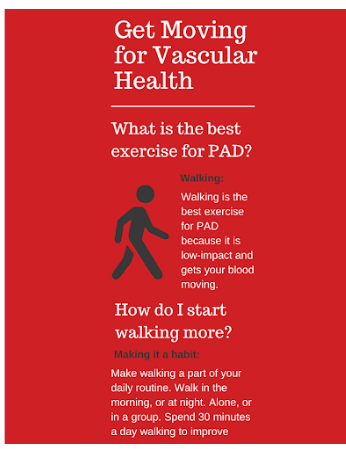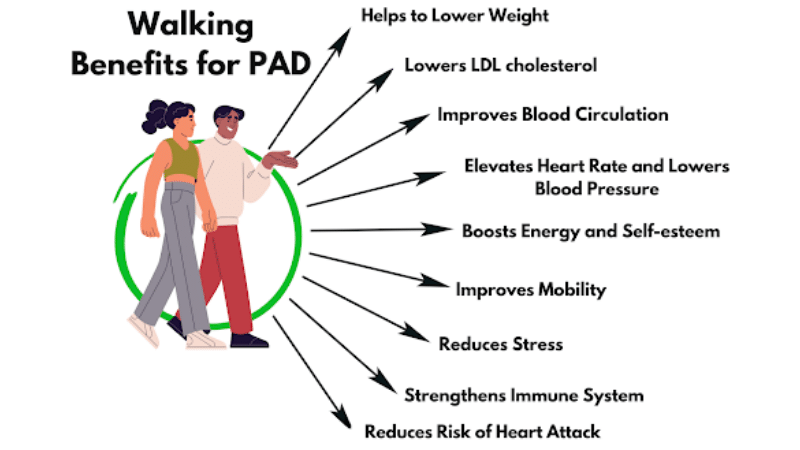Did you know a simple walk can be a powerful weapon against heart disease?
Studies done at Harvard Health found that individuals who spend 20 to 30 minutes a day walking can cut their risk of heart disease by 30%.¹
Want to keep your heart and legs healthy? Walking is a powerful tool for boosting vascular health. It can also help prevent a condition called peripheral artery disease (PAD), it’s time to start prioritizing walking for vascular health. Walking is a low-impact workout that can be done at home and at your own pace. Here’s what you need to know about the correlation between walking and cardiovascular health.
What is Peripheral Arterial Disease (PAD)?
Peripheral artery disease is a serious vascular condition where plaque builds up in the arteries and slows blood flow. This progressive condition can make it more challenging for individuals to walk or climb stairs. It can also cause leg pain, numbness, hair loss, and discoloration. Studies suggest that PAD affects nearly 10% of the American population, and over 30-40% experience claudication symptoms.²
At USA Vascular Centers, we offer minimally invasive treatments for PAD that can help alleviate symptoms associated with the condition. If you’re exhibiting symptoms of PAD, we recommend scheduling an appointment with one of our vascular doctors for a proper diagnosis. If you’re diagnosed with PAD, our team will discuss the different treatment options available for your condition and develop a personalized management plan to help you walk further and live better.
Role of Walking in PAD Management
Is walking for PAD good? The short answer is yes. Incorporating daily walks and exercise into your routine can help improve mobility and lessen the severity of your PAD symptoms. While walking can’t cure PAD, it can help enhance your quality of life and help you combat the pain associated with the condition. When you prioritize walking for at least 20-30 minutes every day, you’ll slowly build strength, increase your pace, and feel more comfortable with longer distances.
Benefits of Walking for PAD
There are many benefits to walking for PAD. Whether you’re walking on a treadmill for 20 minutes or taking a stroll around your neighborhood. Walking can help individuals with peripheral artery disease manage symptoms and improve mobility. Some of the benefits of walking for PAD include:
- Improving blood circulation
- Elevating your heart rate
- Boosting energy and self-esteem
- Improving mobility
It’s important to note that walking cannot reverse PAD. It can help lessen the severity of the symptoms associated with the condition but cannot completely eliminate it. If you have PAD, we recommend exploring the best treatment options for your specific case by scheduling a consultation with one of our vascular doctors.
Vascular Health Benefits of Walking
Walking can also be beneficial for your overall health. In addition to improving vascular health, this low-impact activity can help you burn more calories and help you maintain a healthy weight. Walking briskly on a treadmill or outside is also an easy way to increase your heart rate and improve blood circulation. Some studies suggest that a brisk 30-minute walk can reduce your “bad” cholesterol and raise your “good cholesterol.³ Prioritizing low-impact activity can also lower your risk of stroke or developing cardiovascular diseases. Waking at least 8,000 steps has been found to substantially lower risks for Type 2 diabetes, dementia, depression, cancer, and sleep apnea, according to the Centers for Disease Control and Prevention.
Innovative Treatment Options at USA Vascular Centers
If you have PAD, you’ll want to start by scheduling a consultation with a vascular doctor. They will develop a personalized treatment plan based on the severity of your symptoms. At USA Vascular Centers, we offer three minimally invasive, non-surgical treatments. These include:
- Angioplasty: A small balloon is inflated inside the artery to compress the plaque against the artery walls.
- Stent Placement: A small stent is placed inside the artery after an angioplasty.
- Atherectomy: A small blade or laser is inserted into the artery to cut away and remove plaque.
Our vascular doctors perform all three treatments in our state-of-the-art facilities. As part of the treatment plan, the doctor may also recommend lifestyle changes and personalized exercise regimens.
Integrating Walking with PAD Treatment
After your PAD treatment, one of our vascular doctors may recommend walking for vascular health. Many different walking programs and home-based exercises can help improve mobility and manage symptoms associated with PAD.
Here’s a safe and effective approach to integrating walking into your PAD management plan:
- Start Slow: Begin with short walks, ideally two to five minutes, at a comfortable pace that doesn’t cause pain. Gradually increase the duration by two to three minutes each week.
- Listen to Your Body: Pay close attention to your pain levels. Discomfort is okay, but stop if the pain becomes moderate (four to six out of ten) or severe (seven to eight out of ten). Rest until the pain subsides before continuing.
- Interval Training: Alternate short walking intervals with rest periods. Start with a comfortable pace for 30 seconds, followed by 30 seconds of rest. Gradually increase the walking time and shorten rest periods as tolerated.
- Focus on Consistency: Aim to walk at least three to five times a week. Consistency is key to improving your circulation and managing PAD symptoms.
- Terrain Matters: Start on flat, even surfaces and avoid inclines or uneven terrain until your doctor advises otherwise.
- Warm-up and Cool-down: Always include a five-minute warm-up (light walking or stretching) before starting your walk and a 5-minute cool-down (slow walking and static stretches) afterward.
Remember: It’s important to consult with your doctor before starting any new exercise program, especially if you have PAD. They can help you create a personalized walking plan that is safe and effective.
Experience The Benefits of Walking for PAD With USA Vascular Centers
At USA Vascular Centers, we know how challenging it can be to live with PAD. Our team of expert vascular doctors can help you navigate the complexities of your PAD diagnosis and get access to the best treatment plan for your symptoms.
Call us at 888.773.2193 or request a consultation today.
Sources Cited:
- Corliss, J. (2023, February 1). Revitalize your walking routine. Harvard Health.
- Peripheral arterial disease: Epidemiology, natural history, diagnosis and treatment. (n.d.). National Library of Medicine.
- Long Island Health Collaborative. (n.d.). Surprising facts about how walking benefits your health. Activity Tracker.



